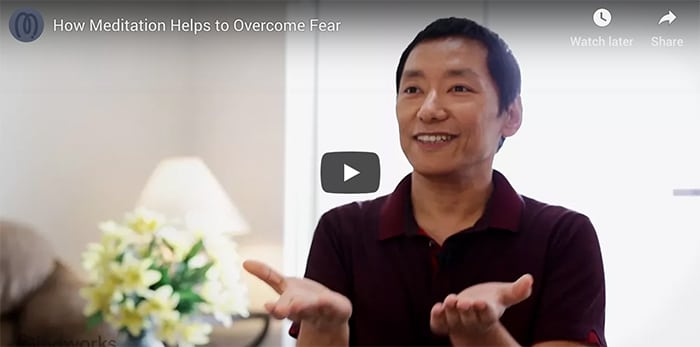What Is Buddhist Meditation?
Category: Buddhist Meditation | Buddhist Path | Popular | Types of Meditation

There are many forms of meditation and many ideas about what meditation is. While different spiritual paths may associate meditation with contemplation, prayer or other practices, Buddhist meditation is specifically associated with mindfulness and awareness. Indeed, although there are a lot more forms of Buddhist meditation than you might think, they all have mindfulness and awareness as their common denominator.
Buddhist meditation practices help meditators cultivate core values of awareness, tranquility and insight. According to Buddhist philosophy, when we understand our mind and emotions better, we can work with our actions and reactions in a way that leads to well-being and happiness – our own and for those around us. And the more we appreciate the importance of others’ well-being and happiness, the more we experience compassion and love. Mindfulness and awareness is the key.
The development of Buddhist meditation
According to most historians, the Buddha was born to a royal family about 6 centuries BCE in what is now Nepal. After having experienced both the luxuries of his noble lineage and the rigors of an ascetic spiritual path, the Buddha chose to eschew these extremes in favor of a practice based on moderation, introspection and stable awareness. This practice led to his spiritual awakening in India, following which he spent many decades teaching what he had discovered to anyone who was interested: royalty, merchants, farmers, paupers, monks and nuns.
In turn, his disciples put the teachings into practice and gained insights that they then transmitted to others. Buddhism spread throughout Asia, adapting to the customs and, to a certain degree, the belief systems of the lands where it took root. Although there are perceptible differences in the way that Buddhism is practiced today in, say, Mongolia, Sri Lanka, Tibet, Korea and Thailand, they all have at their core the practice of mindfulness and a philosophy based on the Buddha’s first cycle of teachings, known as the Four Noble Truths.
These early teachings focus on why we experience dissatisfaction, how we can put an end to the unwholesome patterns that cause this suffering by cultivating awareness and training the mind, and the freedom experienced when we are no longer fettered by these unwholesome patterns.
The 4 Foundations of Mindfulness. The Buddha taught mindfulness meditation as an essential component of the journey to freedom. In a famous discourse, he suggested that in order to cultivate awareness, there are four things to be mindful of:
- The body, as in: what is perceived by the senses right now?
- Feelings, as in: how do we feel about those perceptions? Do we accept or reject them?
- Mind, as in: what emotional reactions and thoughts are we experiencing based on this?
- Phenomena, as in: what is the nature of our perception of things?
What’s different about Buddhist mindfulness meditation? Anything?
The basis of mindfulness meditation, “Buddhist” or not, is non-judgmental awareness of what we are experiencing in the moment. Sitting and following the breath to keep the mind focused and aware is a very well-known mindfulness method.
What sets Buddhist mindfulness meditation apart is the importance of motivation and the development of insight or vipassana meditation. Buddhist motivation focuses on liberation from suffering and confusion, and the attainment of freedom. Buddhists generally take a moment before beginning their practice to recall their motivation and express their confidence in the sanity of their journey. After their session has ended, they reiterate their motivation and confidence. In their opening and closing prayers, many Buddhists give voice to their wish that meditation will give them tools to be better able to help others. For Buddhists, the qualities of compassion and discernment are very important and are usually included in these prayers, such as the Four Immeasurables or boundless thoughts. Naturally, you don’t have to be a Buddhist to appreciate the importance of these qualities. Another very useful set of tools to understand the keys to liberation are found in the four seals of dharma.
The combination of mindfulness practice (shamatha) and awareness practice (vipashyana) is unique to Buddhist practice, and forms the basis for growth on the spiritual path. The mindfulness technique itself is not religious in any way and can be very beneficial to all. Note that there are many other Buddhist practices that are specific to Buddhism. Some are quite connected to their country’s culture and require study and training (Tibetan Buddhist mantra and visualization practices, for example) while others are very accessible.
How to practice Buddhist mindfulness meditation
To practice mindfulness meditation with a Buddhist slant, begin your session by taking a moment to recall why you’re meditating. What is your motivation? Think about what your goal is and how meditation can help you reach it. Connect with your compassionate, caring heart. Then sit in a posture that supports your practice and settle your mind on the rhythm and feel of your breath.
As you practice, your mind will be distracted by all sorts of ideas – what’s been done, what needs doing, and how you feel about all that. Great! Notice these thoughts and how they vie for your attention, then gently but firmly bring your mind back to the breath.
When you start meditating it often seems like you’re having more thoughts than ever. Don’t panic, and don’t try to stop these wandering thoughts. Just acknowledge their presence and let them come and go without pursuing them further. The goal is to become aware of whatever arises in the mind – whether “desirable” or not. Thoughts are always there, we’re just usually too busy to notice. Thanks to mindfulness, we learn that there’s a powerful alternative to distractedness: awareness. To develop awareness, we train in being present, a few minutes at a time.
At the end of your allotted sit time, you might revisit your motivation and confidence in the sanity of the mindful journey, develop a sense of gratitude, give voice to a prayer or affirmation, etc. The idea is to avoid springing up off the cushion and back into the usual routine too abruptly. Acknowledge that your practice and the incentive behind it are important. As your practice grows, carry this motivation and awareness into your daily life’s activities.
In this short video clip, meditation expert Trungram Gyalwa talks about how thinking of others with compassion lessens our own self-centeredness, and therefore reduces our own fear.







